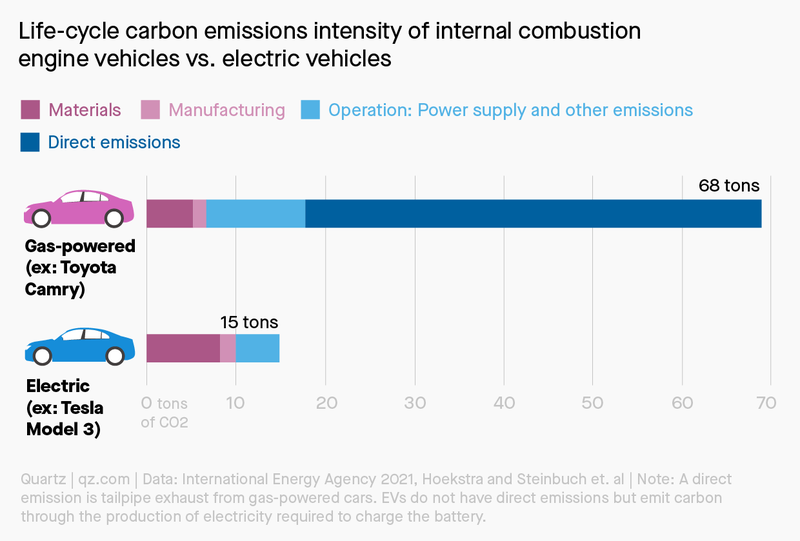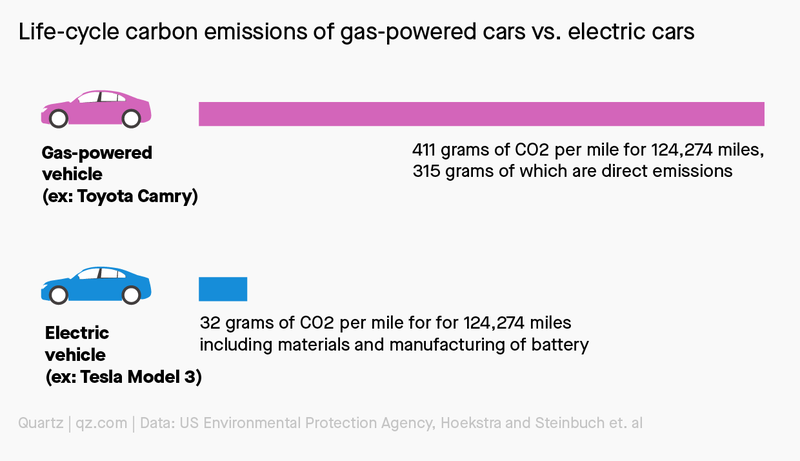EVs are far cleaner than gas-powered cars — even if batteries require more mining
The global transition to renewable energy will require vast amounts of minerals. Those minerals will need to be extracted from the ground, processed into purer forms, and turned into batteries and magnets to power things like electric vehicles.
So if the battery in an electric vehicle, or EV, demands so much mining and manufacturing, are they really so much cleaner than gas-fueled internal combustion engines?
Read more
The answer is yes.
Are electric vehicles better for the environment?
Comparing greenhouse gas emissions of internal combustion vehicles and EVs throughout their entire life cycles, an EV can emit about a quarter the carbon dioxide as its gas-powered counterpart, according to calculations (PDF) by the International Energy Agency, US Environmental Protection Agency studies, and academic research (PDF).
While mining the material inputs required for an EV battery — and the process of making it — emit more carbon dioxide, the direct emissions from driving an internal combustion engine vehicle over its lifetime far outstrips the total lifecycle emissions of an EV.

A typical passenger vehicle like the Toyota Camry emits about 68 tons of CO2 in its lifetime, compared to 15 tons of CO2 emitted for an electric Tesla Model 3 — which includes CO2 emitted during the extraction of materials, the manufacturing of the battery, and power supply, which are the emissions made through charging the battery and operating the vehicle.
Quartz used data from the EPA and the International Energy Agency for these calculations, which were made with the help of Auke Hoekstra, a senior advisor on smart mobility at the Eindhoven University of Technology in the Netherlands.

Minimizing the environmental impacts of mining for battery minerals
While EVs are undeniably lower-emission than gas-powered cars, it is also true that surging demand for EVs and batteries will require a significant expansion in mining—and the environmental disturbances and waste that come with it.
That’s why it will be important to develop and deploy mining and processing innovations that reduce mining waste and toxicity, as researchers from Australia’s University of Queensland outlined in a recent journal article.
According to the researchers, waste generated by copper, nickel, manganese, and lithium extraction will total nearly one trillion tons over the next 30 years. But there are ways to dramatically reduce that waste, which includes waste rock resulting from mining and excavation, as well as byproducts known as tailings that are left behind after the target mineral is extracted.
The researchers proposed several alternative extractive methods. One involves reprocessing waste rock and tailings to extract residual amounts of valuable minerals. Another is known as environmental desulphurization, a process that separates sulphide minerals to reduce the toxicity of tailings.
The repurposing of byproducts from one mining activity to economize another mining process is already a well established method. For example, the Chinese state-owned iron and steel giant Baotou Steel mines iron ore that contains rare earth metals, then provides the critical metals to its rare earths subsidiary. Similarly, a US-EU rare earth supply chain takes advantage of monazite sands left behind from mining heavy minerals for titanium and zirconium.
Insuring against human rights violations in EV production
Another major concern is the high human cost associated with mining projects in some countries. The Democratic Republic of Congo’s cobalt mining industry, for example, has been linked with worker exploitation, child labor, and other human rights violations.
There are also indications of forced labor in the Chinese EV battery supply chain. Just last month, a company backed by Chinese battery giant CATL won a bid for exploration rights to a lithium mine in the northwestern region of Xinjiang, where the Chinese Communist Party is accused of waging a systematic campaign of human rights abuses against the Uyghur ethnic minority.
More from Quartz
What higher H-1B fees will mean for Indians hoping to work in the US
More than half of US nursing homes are unprofitable—and it's about to get a lot worse
Sign up for Quartz's Newsletter. For the latest news, Facebook, Twitter and Instagram.

